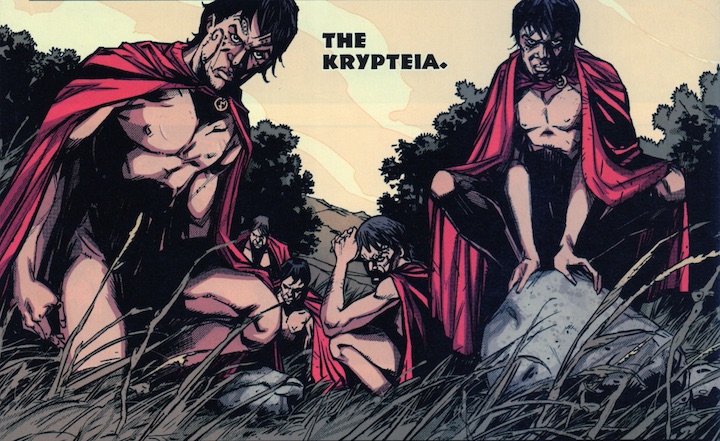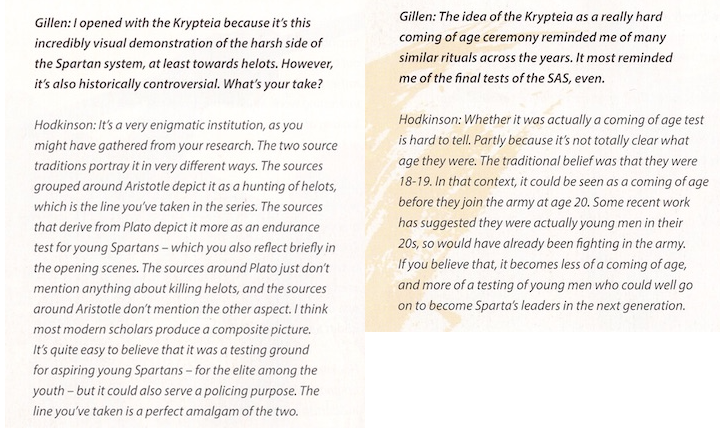
August 13, 2020, by Lynn Fotheringham
The Krypteia, part 2
(Διαβάστε στα Ελληνικά.) (Revised 24/08/20.)
Three, by Kieron Gillen & Ryan Kelly; chapter/issue 1, cont. [For an introduction to Three, see this post.]
CONTENT: HISTORICAL SLAVERY, MURDER OF THE ENSLAVED, VIOLENCE
In the last post I introduced the Spartan institution called the krypteia/krupteia/crypteia, and showed how the way it is depicted in Three’s prologue matches precisely the description given in Plutarch’s Life of Lycurgus. But some aspects of the depiction are interpretations of the other ancient source on this institution, Plato’s Laws (633b-c):
ΜΕΓΙΛΛΟΣ: Ἔτι τοίνυν καὶ τὸ τέταρτον [τῆς ἀνδρείας ἐπιτήδευμα] ἔγωγε πειρῴμην ἂν λέγειν τὸ περὶ τὰς καρτερήσεις τῶν ἀλγηδόνων πολὺ παρ᾿ ἡμῖν γιγνόμενον ἔν τε ταῖς πρὸς ἀλλήλους ταῖς χερσὶ μάχαις καὶ ἐν ἁρπαγαῖς τισὶ διὰ πολλῶν πληγῶν ἑκάστοτε γιγνομέναις· ἔτι δὲ καὶ κρυπτεία τις ὀνομάζεται θαυμαστῶς πολύπονος πρὸς τὰς καρτερήσεις, χειμώνων τε ἀνυποδησίαι καὶ ἀστρωσίαι καὶ ἄνευ θεραπόντων αὐτοῖς ἑαυτῶν διακονήσεις, νύκτωρ τε πλανωμένων διὰ πάσης τῆς χώρας καὶ μεθ᾿ ἡμέραν. |
MEGILLUS: The fourth [institution having to do with courage] also I may attempt to state: it is the training, widely prevalent amongst us*, in hardy endurance of pain, by means both of manual contests and of robberies carried out every time at the risk of a sound drubbing; moreover, the “Crypteia,” as it is called, affords a wonderfully severe training in hardihood, as the men go bare-foot in winter and sleep without coverlets and have no attendants, but wait on themselves and rove through the whole countryside both by night and by day. |
- Text and translation by G. Bury, Loeb Classical Library vol. 187, 1926.
* The word ‘us’ is used because the speaker at this point in the dialogue is a Spartan, but remember that the dialogue is written by Plato – an Athenian.
Unlike Plutarch, Plato says nothing about the krypteia murdering Helots here, but that may simply be because his emphasis is on ‘hardy endurance of pain’ by the Spartans; his other references, to ‘manual contests’ and ‘robberies carried out … at the risk of a sound drubbing’, are also far from being complete descriptions of the practices in question.

THREE ch.1, p.2 panel 5
This passage has been interpreted by some historians as indicating that the krypteia was a kind of rite of passage that Spartiate youths (or the highest-achieving ones) went through at a particular age. In Three, the invented detail of the face paint hints at the activity’s possible ritual aspect. The fact that the youths are naked picks up on the phrase ‘go bare-foot in winter’ and suggests the ‘training in hardihood’. Kieron has also said that this training and ritual aspect of the krypteia led him to connect it with sport, and it is generally well-known that the Greeks participated in sport naked.
Here’s how Kieron and the historical consultant, Stephen Hodkinson, discussed the krypteia in THREE: A CONVERSATION – which was printed in four sections at the back of issues 2-5 and then as a whole at the back of the collection:

THREE: A CONVERSATION, extract
The most recent scholarship on the krypteia (that I know of!) is in Italian, French or German. I give links to a couple of open-access articles below.
The next couple of posts will look at a few more specific details of the way the krypteia is represented in the prologue.
Bibliography:
Massimo Nafissi, ‘Kryptaiai spartane’ [in Italian], in Los espacios de la esclavitud y la dependencia desde la antigüedad (edited by Beltrán, Sastre & Valdés) 2015, pp.201-229. [Summary in English]
- the author argues that Plato describes an earlier version of the krypteia, while Plutarch’s more murderous version reflects a later development.
Jean-Christophe Couvenhes, ‘Les kryptoi spartiates’ [in French], in Sparte hellénistique: IVe–IIIe siècles avant notre ère (edited by Christien & Legras) 2014, pp.45–76. [Summary in English]
- the author argues for a less ritualised, more militarised interpretation of the krypteia.
Note: I may refer to/quote comments on this post either in later blog-posts or in a research publication. More information about my audience-research, including a Privacy Notice and ways of getting hold of the book.
Three © Kieron Gillen & Ryan Kelly 2013. Used with permission.
No comments yet, fill out a comment to be the first

Leave a Reply